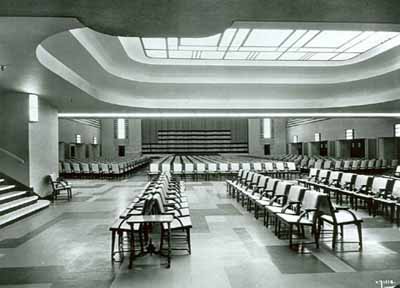Eaton's 7th Floor Auditorium and Round Room National Historic Site of Canada
Toronto, Ontario

Auditorium
© Eaton's of Canada Ltd. / Eaton Canada ltée., c. 1930.
Address :
2 College Street (444 Yonge Street), Toronto, Ontario
Recognition Statute:
Historic Sites and Monuments Act (R.S.C., 1985, c. H-4)
Designation Date:
1983-06-13
Dates:
-
1930 to 1930
(Construction)
-
1930 to 1970
(Significant)
-
2000 to 2003
(Restoration)
Event, Person, Organization:
-
Jacques Carlu
(Architect)
-
René Cera (designer)
(Architect)
-
Ross & Macdonald
(Architect)
-
Sproatt & Rolph
(Architect)
-
Natacha Carlu (artist)
(Builder)
Other Name(s):
-
Eaton's 7th Floor Auditorium and Round Room
(Designation Name)
-
The Carlu
(Other Name)
-
Former Eaton's College Street Store
(Other Name)
Research Report Number:
1983-023, 2005-SDC/CED-061, 2005-SDC/CED-087
Plaque(s)
Existing plaque: 2 College Street (444 Yonge Street), Toronto, Ontario
Opened in 1931, the luxurious rooms and foyer on the 7th floor of this building are among the most outstanding Art Deco interiors in Canada. Designed by Jacques Carlu and René Cera, with murals by Natacha Carlu, they seamlessly integrate structure and art. Bands of white flashed opal glass lighting, geometric Monel metal and bronze finishes, and black Vitrolite create flowing, curvilinear spaces. The glass chandelier and fountain in the Round Room evoke the age of radio and epitomize the contemporary style. Superb acoustics in the auditorium drew famous performers to this venue, which hosted many important cultural events.
Description of Historic Place
Eaton's 7th Floor Auditorium and Round Room National Historic Site of Canada comprises a former restaurant (Round Room), large foyer (crush space) and auditorium recognized as a tour de force of Art Deco design. These spaces are located in the former Eaton’s College Street store in downtown Toronto. Recently restored, these rooms are now a private events venue within the rehabilitated College Street building. The entire building, designed by Canadian architects Ross and Macdonald with Sproatt and Rolph as associates, has been officially recognized by the Municipality of Toronto under the Ontario Heritage Act. The designation of national historic significance refers only to the Auditorium, the former restaurant (Round Room) and the associated foyer (crush space).
Heritage Value
Eaton’s Seventh Floor Auditorium and Round Room was designated a national historic site of Canada in 1983. It was designated because: the Eaton Auditorium, Round Room and associated crush space are outstanding and remarkable examples of Art Deco interior design; and, the Eaton Auditorium was a unique venue for important national and local artistic and cultural events.
The series of Art Deco-style rooms, designed by French architect Jacques Carlu, muralist Natacha Carlu, and architect René Cera within the Eaton’s College Street department store, was built in 1930, opened in 1931 and sealed off by 1970 until they were restored in 2000 - 2003. These rooms, which had hosted significant cultural events of the day and were a favourite gathering place for Toronto’s middle class, are now available for private rentals.
Source: HSMBC, Minutes, June 1983, December 2005.
Character-Defining Elements
Key elements contributing to the heritage value of this site include: the location of the rooms within the former Eaton’s College Street building in downtown Toronto; the suite of rooms, comprising the Round Room, Foyer (crush space) and Auditorium, in their individual volumes and spatial relationships; the incorporation of technology with aesthetic design as in the visual highlighting of sprinkler heads as part of the moulding in the Foyer, the Round Room fountain linked to the lighting system, and decorative air circulation grills; the use of simplified geometric forms, a contrasting colour scheme (gold, black and silver), and a mixture of costly traditional and glossy new materials typical of the Moderne version of Art Deco design; the Round Room as a a domed circle within a square whose corners accommodate raised alcoves lined with back Carrera glass, surviving mural paintings by Natacha Carlu, the original, geometric pattern of Round Room window lites using monel metal and white glass, original linoleum designs, and surviving bird’s eye maple veneer; the L-shaped Foyer (crush space) with surviving original marble panelling; the Auditorium in its original volume, with surviving fixed seating on the balcony level; surviving original wall coverings, original plaster relief sculpture; surviving original art pieces including the Lalique-designed fountain and Natacha Carlu murals, as well as surviving original furniture.